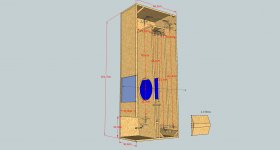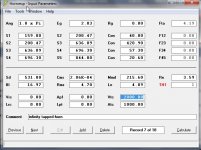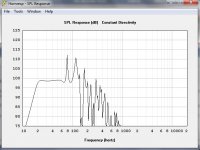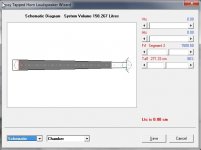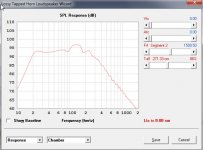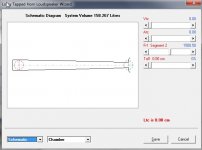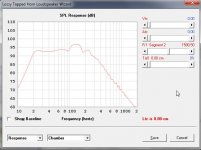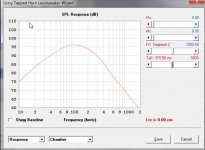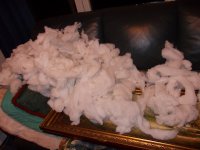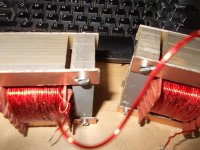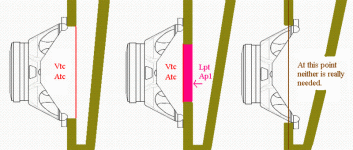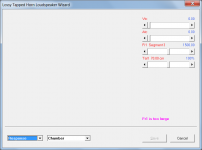I'm the the Loudspeaker Wizard, with a Taped Horn, selected Schematic and Chamber but can't find the Tal1 slider control, also the Chamber picture is a red vertical line,
Hi Ken,
On the main input parameters window, double-click on the Ap1 label in edit mode to change it to Fr, and then select the Loudspeaker Wizard.
Kind regards,
David
This is a great feature.
Hi Oliver,
Don't forget to let me know, if you find any bugs 🙂.
Kind regards,
David
Hi Mårten,
Not any more - see my post above.
Very nice feature indeed. I have already used it in an ongoing project. Thanks David!
Hi Ken,
On the main input parameters window, double-click on the Ap1 label in edit mode to change it to Fr, and then select the Loudspeaker Wizard.
Kind regards,
David
David,
Got it to work, then I saved the result. But when I reopen the file in edit, the result is not applied as I had saved it. If for instance, I only put fill in 30% of section 2 at some density, when I reopen the file, it will have applied the fill density to 100% of all three sections of the horn.
Somewhat related to this is after making adjustments to the fill, saving and then recalculating at the input screen, the fill info is ignored in the spectrum plot.
Don't know if this is what you had intended.
Thanks for a great tool.
Regards,
Ken
Don't know if this is what you had intended.
Hi Ken,
The absorbent filling material feature is confined to the Loudspeaker Wizard - Fr1 and Tal1 settings are not saved as part of the data record.
The post linked below also refers (note that the functionality has changed slightly since the posting).
http://www.diyaudio.com/forums/subwoofers/119854-hornresp-402.html#post3761101
Kind regards,
David
Hi Kees,
If you want the cross-sectional height to increase linearly over the full length of the tapped horn when width is held constant, then do the following:
1. Specify a standard three segment tapped horn with Par flares, so that the areas expand linearly.
2. Open the Loudspeaker Wizard and set S2 and S3 to Auto, and then press the Save button.
3. When exporting the horn data set the Width values to the required constant width and specify Con width flares.
Kind regards,
David
Hi David
Thanks for your help, I will do this.
I did also discover that the automatic button is important, I do use them, except the last for the inverted horn because this is a big hole and do nothing at all in my design, but need to implement afcourse.
have a nice day/night there.
regards
kees
Hi David
In the past I did make this tapped horn design, still not yet tryed out yet.
I have a question because of the cone correction, I can do a try with hornresp to include that in the throat with the VTC and ATC function to put extra 2 liter to it because of the driver front volume therefore I had done this conecorrection like in photo, someone has advise me about it.
I did try the VTC/ATC function to put big volume extra, it did make the respons even better?? I think cone correction is not needed for all speakers here.
Maybe you can give a advise to me how I can do this properly, do I need always to use VTC/ATC combined or can I only use VTC? or ATC?
Do you like the response? this is a car woofer not so expensive. Where I can find damping material in hornresp?
thanks
kees
In the past I did make this tapped horn design, still not yet tryed out yet.
I have a question because of the cone correction, I can do a try with hornresp to include that in the throat with the VTC and ATC function to put extra 2 liter to it because of the driver front volume therefore I had done this conecorrection like in photo, someone has advise me about it.
I did try the VTC/ATC function to put big volume extra, it did make the respons even better?? I think cone correction is not needed for all speakers here.
Maybe you can give a advise to me how I can do this properly, do I need always to use VTC/ATC combined or can I only use VTC? or ATC?
Do you like the response? this is a car woofer not so expensive. Where I can find damping material in hornresp?
thanks
kees
Attachments
Last edited:
If I go above 1000 with the Fr1 glider things go wrong?, graph go away.
Maybe 1000 and above do not work anyway.
Neat idea this damping, now hornresp gets better then ever, very clever programming also to make it easy to learn.
thanks David for sharing.
Update for the new damping thingie.
I did some tests, I do see that when I move the slider Tal1 nothing happen really, when go above some value I see it jums suddenly to a whole other graph response. You see the first two pictures Tal1 is 0.00 and the resulting graph, and second two pictures you see Tal1 is 271.33, but it is some random effect. it just switch between the two graphs.
Maybe I have find again a bug for you?. be the way the export is now fine, no errors anymore thanks.
see pictures.
further I can make response very nice with damping, I see that I have much to much in it.
Maybe 1000 and above do not work anyway.
Neat idea this damping, now hornresp gets better then ever, very clever programming also to make it easy to learn.
thanks David for sharing.
Update for the new damping thingie.
I did some tests, I do see that when I move the slider Tal1 nothing happen really, when go above some value I see it jums suddenly to a whole other graph response. You see the first two pictures Tal1 is 0.00 and the resulting graph, and second two pictures you see Tal1 is 271.33, but it is some random effect. it just switch between the two graphs.
Maybe I have find again a bug for you?. be the way the export is now fine, no errors anymore thanks.
see pictures.
further I can make response very nice with damping, I see that I have much to much in it.
Attachments
Last edited:
Sorry that I Hijacking this thread a little but I have done the change in the sub what concerns the damping, well as you see on the picture it was a little to much regardiing to hornresp, I have now measure it and fill it with that.
Now I now why the low end has to be boosted, I think this filter can now be removed. see the last picture of the graph of hornresp when I do use al the fiber you see on photo, well, not much low end anymore, but I am curieus about the sound now, because will do it boom? because of to little damping, now hornresp get the test, I let now..
The trafo,s you see, I have made myself, with a gap I can adjust, so I have a easy way to go rfom 5 mH to 22 mH and 10 Mh to 30 mH, exact adjustable.
I let now if sub perform better now without booms with hornresp damping equation.
regards
kees
Now I now why the low end has to be boosted, I think this filter can now be removed. see the last picture of the graph of hornresp when I do use al the fiber you see on photo, well, not much low end anymore, but I am curieus about the sound now, because will do it boom? because of to little damping, now hornresp get the test, I let now..
The trafo,s you see, I have made myself, with a gap I can adjust, so I have a easy way to go rfom 5 mH to 22 mH and 10 Mh to 30 mH, exact adjustable.
I let now if sub perform better now without booms with hornresp damping equation.
regards
kees
Attachments
Last edited:
Fr1 and Tal1 settings are not saved as part of the data record.
The next release of Hornresp will save the Loudspeaker Wizard Fr1 and Tal1 parameter values as part of the permanent data record.
Hi Kees,
I am not sure that there is much to be gained by including the cone correction panel blocks as shown in your sketch. It is probably sufficient just to specify an appropriate throat chamber which takes the driver front volume into account. See the attachment below for details of three possible configurations. In Hornresp, it is necessary to specify values for both Vtc and Atc. It is not possible to use only Vtc or Atc.
More importantly - do you like the response? 🙂.
From your later posts, I assume that you have now found what you were looking for 🙂.
Kind regards,
David
I have a question because of the cone correction, I can do a try with hornresp to include that in the throat with the VTC and ATC function to put extra 2 liter to it because of the driver front volume therefore I had done this conecorrection like in photo, someone has advise me about it.
I did try the VTC/ATC function to put big volume extra, it did make the respons even better?? I think cone correction is not needed for all speakers here.
Maybe you can give a advise to me how I can do this properly, do I need always to use VTC/ATC combined or can I only use VTC? or ATC?
I am not sure that there is much to be gained by including the cone correction panel blocks as shown in your sketch. It is probably sufficient just to specify an appropriate throat chamber which takes the driver front volume into account. See the attachment below for details of three possible configurations. In Hornresp, it is necessary to specify values for both Vtc and Atc. It is not possible to use only Vtc or Atc.
Do you like the response?
More importantly - do you like the response? 🙂.
Where I can find damping material in hornresp?
From your later posts, I assume that you have now found what you were looking for 🙂.
Kind regards,
David
Attachments
Hi Kees,
Too much absorbent material has been specified in the segment. Reduce Fr1 and/or Tal1.
Fr1 specifies the flow resistivity of the absorbent material in a given segment, and Tal1 specifies the amount of filling in the segment as a percentage and also as a length. The first half of the Tal1 slider progressively fills the segment from the throat end. The second half of the Tal1 slider progressively fills the segment from the mouth end. If either Fr1 or Tal1 is zero, the segment contains no absorbent material.
Kind regards,
David
If I go above 1000 with the Fr1 glider things go wrong?, graph go away.
Too much absorbent material has been specified in the segment. Reduce Fr1 and/or Tal1.
I did some tests, I do see that when I move the slider Tal1 nothing happen really, when go above some value I see it jums suddenly to a whole other graph response. You see the first two pictures Tal1 is 0.00 and the resulting graph, and second two pictures you see Tal1 is 271.33, but it is some random effect. it just switch between the two graphs.
Fr1 specifies the flow resistivity of the absorbent material in a given segment, and Tal1 specifies the amount of filling in the segment as a percentage and also as a length. The first half of the Tal1 slider progressively fills the segment from the throat end. The second half of the Tal1 slider progressively fills the segment from the mouth end. If either Fr1 or Tal1 is zero, the segment contains no absorbent material.
Kind regards,
David
Maybe saving filter data as well?
Hi Mårten,
I am looking at the possibility of allowing the user to save the parameter values for a given passive filter to a stand-alone file, which can then be retrieved as required. The feature would not apply to active filters, or to the Le Cléac’h option. Each passive filter design would have a separate file.
As previously indicated, I would rather not include the filter parameter values in the main data record because in most cases the required additional fields would probably remain empty, making the Hornresp.dat file unnecessarily large. The data file will already become 12 percent larger in the next release, when Fr1 and Tal1 absorbent material parameter values are added.
Kind regards,
David
Just one thought on the data saved: Would it be possible to write the Data in XML Format, so it would be compatible between future releases and easy to write external tools to deal with the data (e.g. building the same design with different speakers just by simply copying one record an exchanging the driver parameters for each different incarnation of the speaker - when stored in XML, this is very easy to do with a simple external tool). Editing tools for bigger collections (like mine, some 100 designs) could be done by other people (even a driver database could be established like we once had with the thielesmall-website - and external people coudl prvide data for this one, giving an hornresp export button which could add drivers to hornresp records (new ones or existing ones...).
The size of the record data should be no problem, in times where we send videofiles per mail (sigh...), a few kb more ore less are not tha "Big a deal" IMHO. It could be zipped, if necessary (libs for this are freely and easily available).
A big advantage would be that if more features will be saved in the record in the future (damping, filters, etc..), the danger of corrupting the file when opening it with an older hornresp version is very small - and even older versions could use the new files (without the new features of course). A simple storage of the version it was safed with could be used for a popup message that this record requires a more recent version of hornresp.
Worth a thought?
The size of the record data should be no problem, in times where we send videofiles per mail (sigh...), a few kb more ore less are not tha "Big a deal" IMHO. It could be zipped, if necessary (libs for this are freely and easily available).
A big advantage would be that if more features will be saved in the record in the future (damping, filters, etc..), the danger of corrupting the file when opening it with an older hornresp version is very small - and even older versions could use the new files (without the new features of course). A simple storage of the version it was safed with could be used for a popup message that this record requires a more recent version of hornresp.
Worth a thought?
Last edited:
Hi David
Indeed I have found the damping, congratulations, I have try the hornresp setup and have 4dB more low end output without the boom, it is al pretty close.
I did also figure out the cone correction, I did include it and it is not worth the effort to include that piece of wood, the change is minimum or better say, not to see it in graph, there are speakers who do be sensitive to it, but then play with S1 and the VTC/ATC function do correct it without the need of the correction of wood.
What concerns the damping and if I go higher then 1000, maybe it is better to do a massagebox in it who says to much fiber or something when I go to high? give program a nice look. now if higher then 1000 it go do strange.
regards and keep the good working going.
kees
Indeed I have found the damping, congratulations, I have try the hornresp setup and have 4dB more low end output without the boom, it is al pretty close.
I did also figure out the cone correction, I did include it and it is not worth the effort to include that piece of wood, the change is minimum or better say, not to see it in graph, there are speakers who do be sensitive to it, but then play with S1 and the VTC/ATC function do correct it without the need of the correction of wood.
What concerns the damping and if I go higher then 1000, maybe it is better to do a massagebox in it who says to much fiber or something when I go to high? give program a nice look. now if higher then 1000 it go do strange.
regards and keep the good working going.
kees
Hi Sabbelbacke,
Hornresp.dat is a random access file containing a contiguous data string. It does not lend itself to being converted into individual records containing comma-separated-variables, which would be required for the data to be read directly in Excel.
Changing Hornresp.dat to a sequential access file with csv format would enable the file to be opened in Excel (similar to the csv exported chart data, for example), but it would not allow records to be accessed randomly, which is a feature of the program that I would like to retain.
To include filter parameters in the Hornresp.dat file would require space to be reserved for another 56 values in each record. In most cases, the reserved space would probably not be used.
This functionality is already provided in Hornresp. Data files are automatically updated as necessary. If Hornresp is used as intended, then it should not be possible to corrupt the Hornresp.dat file. Allowing the user to manually edit records in Excel as proposed, though, could possibly result in all sorts of unintended problems, which I would rather not have to resolve on an individual user basis 🙂.
Kind regards,
David
Would it be possible to write the Data in XML Format
Hornresp.dat is a random access file containing a contiguous data string. It does not lend itself to being converted into individual records containing comma-separated-variables, which would be required for the data to be read directly in Excel.
Changing Hornresp.dat to a sequential access file with csv format would enable the file to be opened in Excel (similar to the csv exported chart data, for example), but it would not allow records to be accessed randomly, which is a feature of the program that I would like to retain.
The size of the record data should be no problem, in times where we send videofiles per mail (sigh...), a few kb more ore less are not tha "Big a deal" IMHO.
To include filter parameters in the Hornresp.dat file would require space to be reserved for another 56 values in each record. In most cases, the reserved space would probably not be used.
A big advantage would be that if more features will be saved in the record in the future (damping, filters, etc..), the danger of corrupting the file when opening it with an older hornresp version is very small - and even older versions could use the new files (without the new features of course). A simple storage of the version it was safed with could be used for a popup message that this record requires a more recent version of hornresp.
This functionality is already provided in Hornresp. Data files are automatically updated as necessary. If Hornresp is used as intended, then it should not be possible to corrupt the Hornresp.dat file. Allowing the user to manually edit records in Excel as proposed, though, could possibly result in all sorts of unintended problems, which I would rather not have to resolve on an individual user basis 🙂.
Kind regards,
David
What concerns the damping and if I go higher then 1000, maybe it is better to do a massagebox in it who says to much fiber or something when I go to high? give program a nice look. now if higher then 1000 it go do strange.
Hi Kees,
If the total damping is too high, then the current chart will be hidden, and a "Fr1 is too large" message will be displayed, as shown in the attachment.
You should include the minimum amount of absorbent material necessary to achieve the desired response. Using too much simply attenuates the output.
Kind regards,
David
Attachments
- Home
- Loudspeakers
- Subwoofers
- Hornresp
